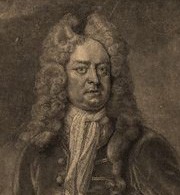George Carpenter, 1st Baron Carpenter
|
Lieutenant-General The Right Honourable The Lord Carpenter |
|
|---|---|

Lord Carpenter by John Faber Jr, after Johan van Diest, about 1719 or soon after.
|
|
| Personal details | |
| Born | 10 February 1657 Ocle Pychard, Herefordshire, England |
| Died |
10 February 1731 (aged 74) Owsebury, near, Westchester, Hampshire, England |
| Nationality | British |
| Spouse(s) | Lady Alice Charlemont |
Lieutenant-General George Carpenter, 1st Baron Carpenter (10 February 1657 – 10 February 1731) was a British soldier who served as Governor of Minorca and as Commander-in-chief of all the forces in Scotland. During the Jacobite rising of 1715 he forced the rebels under Lord Derwentwater to surrender at discretion at Preston, thus securing the throne to the reigning British Royal family.
Carpenter was the second son of Warncombe Carpenter and Eleanor (née Taylor) of Hereford. His father was the sixth son of Thomas Carpenter, Esq., of the Homme or Holme, in the parish of Dilwyn, Herefordshire. He was born at Livers Ocle in Ocle Pychard, Herefordshire (7 miles NE of Hereford City) not Hertfordshire.
In 1693, he married at St. Edmund by licence of the King to Alice, the widow of James Margetson, Esq., a daughter of William Caulfeild, 1st Viscount Charlemont, and Sarah, daughter of Charles Moore, 2nd Viscount Moore. They had two children:
Carpenter, who was a younger son and was educated at a private school in the country, commenced his career as a page to the Earl of Montague in his Embassy to the court of France in 1671, and on returning in the next year, rode as a private gentleman in the 3rd Troop of Guards, from which station was then deemed as honourable introduction to a Military life.
Carpenter went through the posts of cornet, lieutenant, captain and major until he was advanced to that of lieutenant-colonel of the Earl of Peterborough's regiment, in which commission he continued thirteen years.
After his marriage in 1693 he purchased, for 1,800 guineas, a part of the Lady's dowry, the King's own regiment of dragoons, the command he retained until his decease.
He served in the battles in Ireland and warfare in Flanders, and |in Spain. He fought with "unblemished honour and reputation," with "courage, conduct, and humanity" and in 1705 he was made a brigadier-general. In 1707, at the battle of Almanza in Spain he commanded the rear, and brought up the last squadron in the retreat, which saved the baggage of the army.
At the battle of Almenara, in 1710, he was wounded and received "honours" from King Charles of Spain (who later became Emperor of Germany) for his "gallant conduct in the engagement." He was seriously wounded in defending the French and Spanish army breach of the English line at Brihuega. He was taken prisoner and later exchanged. In 1705 he was made a brigadier-general; in 1708 major-general; and in 1710 lieutenant-general. In 1715, he became Member of Parliament for Whitchurch in Hampshire, a seat he held until 1722. In 1715 he was also appointed "envoy extraordinary and plenipotentiary" to the Emperor of Germany who held him with "personal regard and esteem."
...
Wikipedia
